DAVAO CITY (MindaNews / 28 December) – How safe is your house from earthquakes?
Officials from the city’s 26 barangays here gathered at the City Disaster Risk Reduction and Management Office compound on December 21 to listen to geologist Jeffrey Perez of the Philippine Institute of Volcanology and Seismology (Phivolcs) explain the series of powerful quakes that they experienced in the last two months, debunk myths and misconceptions, and raise their awareness on how safe – or unsafe – their houses are.
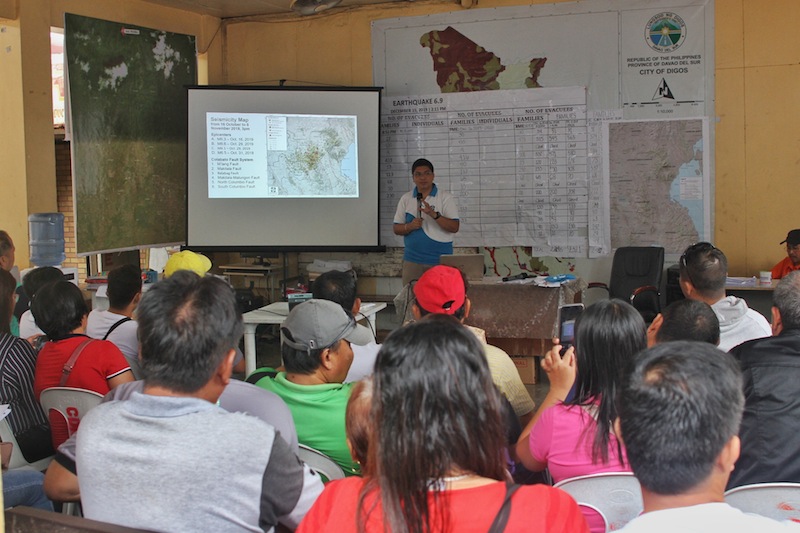 Officials from the 26 barangays of Digos City gather at the City Disaster Risk Reduction and Management Office compound on 21 December 2019 to listen to geologist Jeffrey Perez, Supervising Science Research Specialist of the Philippine Institute of Volcanology and Seismology, explain the series of powerful quakes that they experienced in the last two months, debunk myths and misconceptions, and raise their awareness on how safe – or unsafe – their houses are. MindaNews photo by MANMAN DEJETO
Officials from the 26 barangays of Digos City gather at the City Disaster Risk Reduction and Management Office compound on 21 December 2019 to listen to geologist Jeffrey Perez, Supervising Science Research Specialist of the Philippine Institute of Volcanology and Seismology, explain the series of powerful quakes that they experienced in the last two months, debunk myths and misconceptions, and raise their awareness on how safe – or unsafe – their houses are. MindaNews photo by MANMAN DEJETO
Perez, Phivolcs Supervising Science Research Specialist, asked them 12 simple questions from the “Self-Check for Earthquake Safety of Concrete Hollow Block CHB Houses in the Philippines” to help them determine how safe their house is.
“Sagutin natin ng totoo. Wag magsinungnaling” (Let’s answer truthfully. Don’t lie), Perez told the officials.
The self-check for earthquake safety of Phivolcs is in collaboration with the Association of Structural Engineers in the Philippines (ASEP) under the Japan International Cooperation Agency ( JICA)-Japan Science and Technology Agency (JST) project on the ‘Enhancement of Earthquake and Volcano Monitoring and Effective Utilization of Disaster Mitigation Information in the Philippines.”
It helps owners understand and evaluate the integrity of their houses and their vulnerability to strong earthquakes.
The self-check is initially intended for one to two-storey CHB houses, including residences with small shops, offices, garages and the like, to help owners evaluate their houses by themselves and understand the likely behavior of their houses during a strong earthquake.
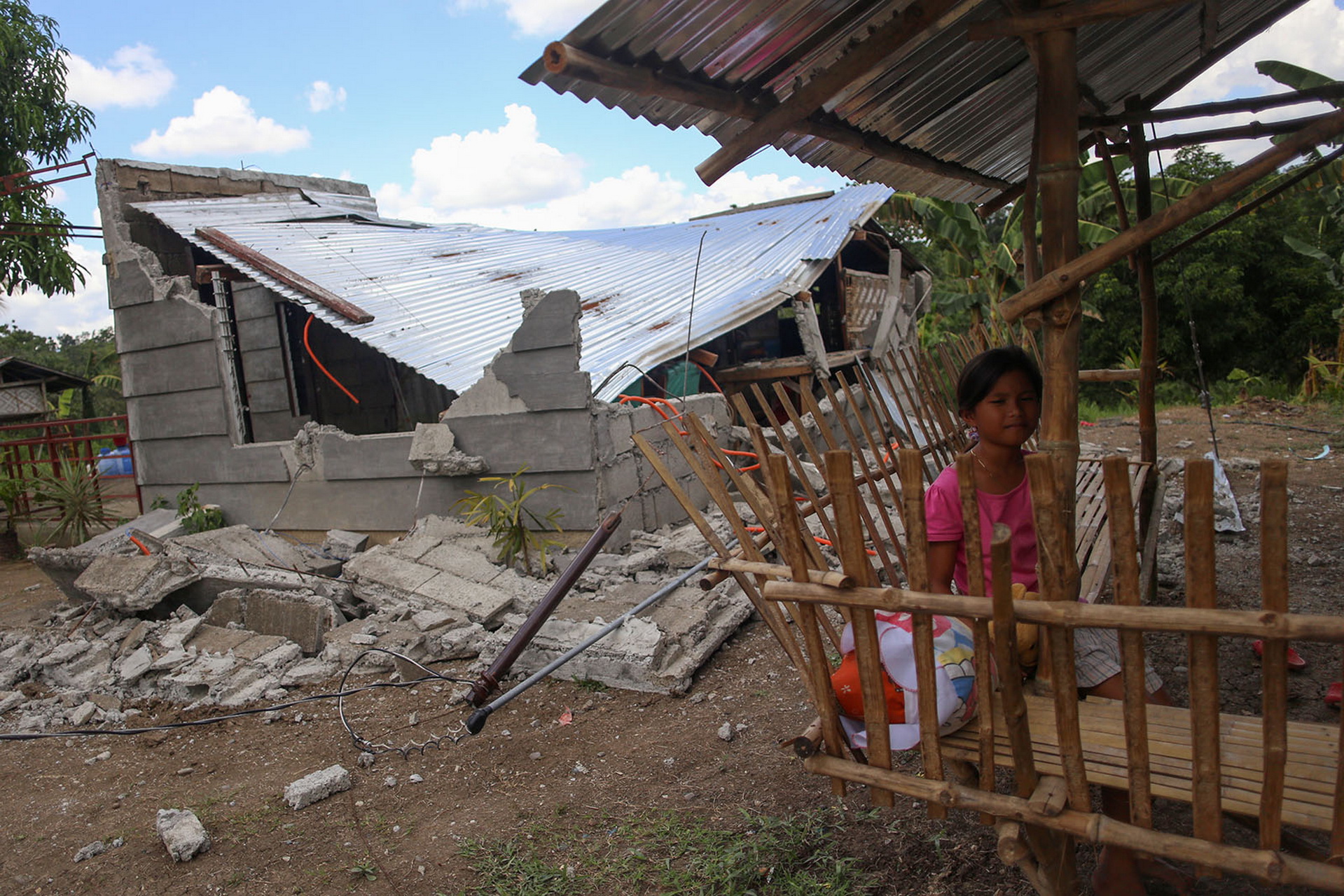 A girl seeks refuge in a shed as a house lies in ruins in Barangay Malawanit in the municipality of Magsaysay, Davao del Sur after a magnitude 6.3 earthquake hit Mindanao Wednesday evening (16 October 2019). MindaNews photo by MANMAN DEJETO
A girl seeks refuge in a shed as a house lies in ruins in Barangay Malawanit in the municipality of Magsaysay, Davao del Sur after a magnitude 6.3 earthquake hit Mindanao Wednesday evening (16 October 2019). MindaNews photo by MANMAN DEJETO
It’s not a new test. It first came out in February 2014 or nearly six years ago but interest in it is just starting to gain ground in Mindanao due to the series of above Magnitude 6 quakes in two months – 6.3 on October 16, 6.6 and 6.1 on October 29, 6.5 on October 31 and 6.9 on December 15 – and largely through Phivolcs’ information and education campaigns, particularly in the quake-hit areas.
In Digos City, Perez was invited by Mayor Josef Cagas to speak before the city’s barangay officials.
By their responses, most of the barangay officials who attended the ‘Earthquake 101’ lecture flunked the house safety test.
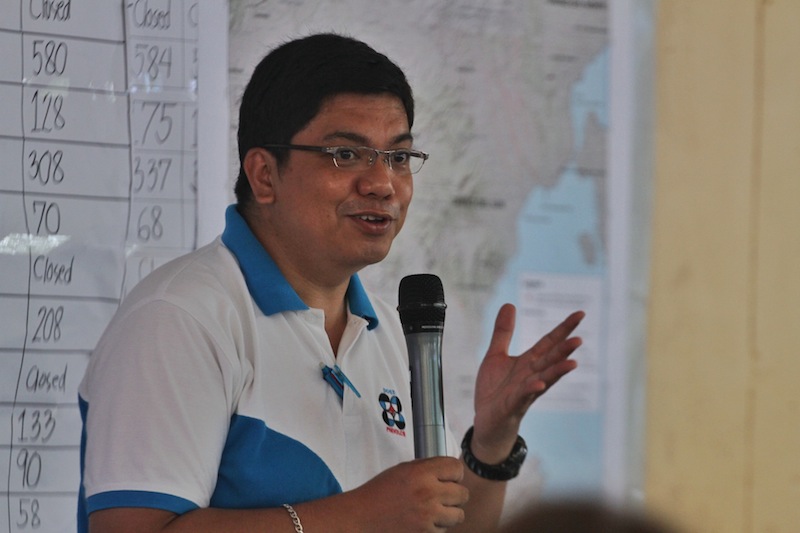 Geologist Jeffrey Perez, Supervising Science Research Specialist of the Philippine Institute of Volcanology and Seismology, MindaNews photo by MANMAN DEJETO
Geologist Jeffrey Perez, Supervising Science Research Specialist of the Philippine Institute of Volcanology and Seismology, MindaNews photo by MANMAN DEJETO
Perez asked who among them secured a building permit when they constructed their houses.
“Sinong kumuha ng building permit?” (who secured building permits?) Perez asked. No hands were raised. “Wala? Yan delikado yan” (None? That is dangerous), he said.
He explained that if they follow the National Building Code, their houses won’t collapse even if it is Intensity 8.
He said many houses near the epicenters of the quakes were destroyed because they used 4-inch hollow blocks instead of the standard 6 and steel bars less than the standard 10 mm.
Also, he said, there should be a post every three meters to ensure the house won’t collapse.
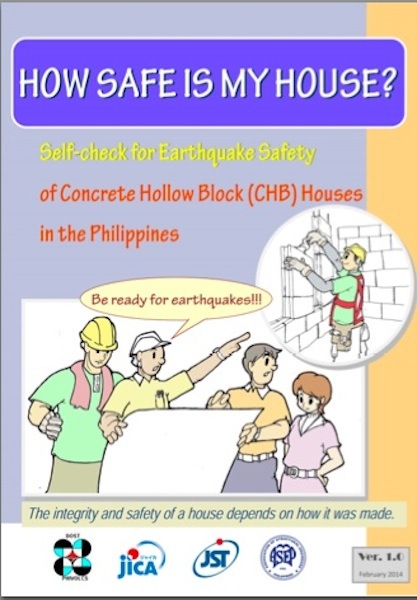 The safety checklist:
The safety checklist:
Question 1: Who built or designed your house? If your answer is licensed civil engineer or architect, you get one point.
Question 2: How old is your house? If built after 1992, you get one point.
Quextion 3: Has your house been damaged by past earthquakes or disasters? If the answer is no, or ‘yes but repaired,’ you score one point.
Question 4: What is the shape of your house? If the answer is ‘regular’ or symmetrical, rectangular, box-type, simple, that’s another point.
Question 5: Has your house been expanded or extended? If the answer is no or ‘yes but supervised by a civil engineer or architect,’ you score a point.
Question 6: Are the external walls of your house 6-inch (150 mm) CHB? If yes, you get another point. I
Question 7: Are steel bars of standard size and spacing used in walls? If you used 10 mm diameter, tied and spaced correctly, you get one point.
Question 8: Are there unsupported walls more than three meters wide? If the answer is ‘none,’ you score a point.
Question 9: What is the gable wall of your house made of? If the answer is ‘light materials, properly anchored CHBs, no gable wall, you get another point.
Question 10: What is the foundation of your house? If the answer is reinforced concrete, that’s one point.
Question 11: What is the soil condition under your house? If your answer is ‘hard (rock or stiff soil), you score another point
Question 12: What is the overall condition of your house? If the answer is ‘good,’ that’s another point.
Perez said a score of 11 to 12 means your house is ‘okay.” A score of 8 to 10 means ‘kailangan ninyong patibayin ang bahay ninyo’ (you need to strengthen your house). A score below 8 is “disturbing. Pwedeng masira sa lindol.”
The self-check states that for those scoring 11 to 12 points, “though this seems safe for now, please consult experts for confirmation.”
For those with scores of 8 to 10, “this requires strengthening, please consult experts” and for those with scores of zero to 7, “this is disturbing! Please consult experts soon.”
In its report posted on December 24, the Perez-led Phivolcs’ Quick Response Team (QRT) on the December 15 quake, recommended that in case of another felt earthquake, do the ‘drop, cover and hold;’ damaged buildings and infrastructure should be inspected by engineers, and should not be used unless assessed as safe; for areas with existing tension cracks, conduct pre-emptive evacuation, and be watchful of landslides triggered by earthquakes and prolonged heavy rainfall; formally train local masons and carpenters on the proper construction practice and use of standard construction materials and reconstruction or construction of houses and buildings should conform with the national Building Code of the Philippines; review and formulation of policies and ordinances that will address the gaps in the issuance of building permits and monitoring of building constructions; and national and local government units in collaboration with non-government agencies should provide psychosocial support such as stress-debriefing to affected communities.
The house safety test can be downloaded from the Phivolcs website.
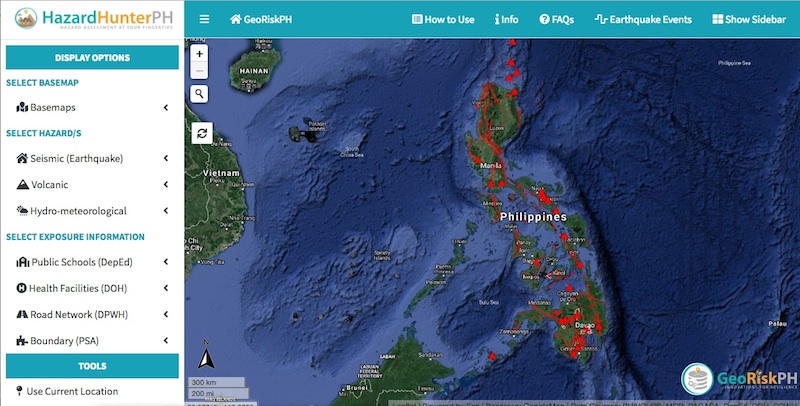 Perez also urged barangay officials to visit hazardhunter.ph which can provide seismic hazard assessment (nearest active fault from your home or office, susceptibility to ground rupture, ground shaking, earthquake-induced landslides, liquefaction and tsunami), volcanic hazard assessment (nearest active volcano, nearest potentially active volcano, nearest inactive volcano), and hydro-meteorological hazard assessment or susceptibility to flood, landslides, storm surge, severe winds. (Carolyn O. Arguillas / MindaNews)
Perez also urged barangay officials to visit hazardhunter.ph which can provide seismic hazard assessment (nearest active fault from your home or office, susceptibility to ground rupture, ground shaking, earthquake-induced landslides, liquefaction and tsunami), volcanic hazard assessment (nearest active volcano, nearest potentially active volcano, nearest inactive volcano), and hydro-meteorological hazard assessment or susceptibility to flood, landslides, storm surge, severe winds. (Carolyn O. Arguillas / MindaNews)
TAKE THE SAFETY TEST
[pdf-embedder url=”https://mindanews.com/wp-content/uploads/2019/12/Flyer-How-Safe-Is-Your-House.pdf”]
